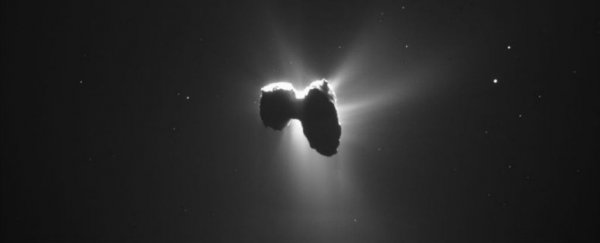Two years ago, the world stopped to watch a little spacecraft make history, as the Philae lander managed to catch up to a comet travelling at 18 km per second (40,000mph), and make a perfect touchdown.
Now it's time to watch the grand finale of that mission, because on Friday morning, the European Space Agency (ESA) will be putting Philae's partner, Rosetta, to sleep - by slamming it into comet 67P.
It's a bittersweet moment, because though it might not feel like it, this is the end of a 12-year mission that's given us some of the most incredible insights into the early days of our Solar System.
Way back in March 2004, the three-tonne Rosetta orbiter launched from Earth with the Philae lander on board, and travelled 6.4 billion kilometres through the Solar System before arriving at Comet 67P/Churyumov–Gerasimenko on 6 August 2014.
Since then, we've run the gamut of emotions, with Rosetta taking the most detailed shots of a comet ever, and Philae finding organic molecules on the surface within 60 hours of landing - before running out of power several days earlier than expected.
More recently, we've said our official goodbyes to the hibernating lander, and then earlier this month, we heard that Rosetta found its partner's lonely grave - Philae crammed itself into a comet hole to die. RIP, little lander.
Now it's time to say goodbye to Rosetta too, because the ESA is ready to put its comet mission to bed.
This Thursday September 29, at 4:50pm Eastern Standard Time, Rosetta will begin a controlled descent for 19 km to its own final resting place in a site on comet 67P called Ma'at, named after the ancient Egyptian goddess of harmony, balance, and order.
But, as Maddie Stone explains for Gizmodo, there's nothing harmonious, balanced, or ordered about Ma'at.
"Littered with goosebump-like boulders and deep, treacherous sinkholes, Ma'at is a rugged and inhospitable place, prone to violent outbursts of gas and dust," says Stone.
"But the very same features that give Rosetta's landing pad a frightening appearance also make it a scientific gold mine. In fact, it's possible this spot could hold the key to understanding how comets form."
Yep, like the total trooper it is, Rosetta will be doing science all the way to its grave.
In fact, thanks to it getting close enough to the comet to slam into it, Rosetta's final hours are expected to yield some of the best data yet from the entire mission, with all kinds of devices kicking into gear during the descent to snap close-up pics, and take measurements of the comet's surface temperature, dust density, solar winds, and gravity field.
It's even possible that Rosetta will veer off-course - like Philae did when it landed - and fall inside a massive pit on the surface of the comet, and there's no telling what it will find inside.
"We're literally diving into the unknown, entering a new zone for science," Rosetta mission scientist Laurence O'Rourke told Gizmodo.
Here's your viewing schedule:
Thursday September 29, 4:50pm EST (September 30, 6:50am AEST): Rosetta begins its controlled descent towards the comet. There will be a commentary and Q&A session from 8:30am - 12:30am EST too, if you feel like prepping.
Friday September 30, 3:55am - 4:05am EST (September 30, 5:55pm - 6:05am AEST): Mission control will start figuring out how it's going to maneuver the spacecraft into its landing spot. The exact time of the crash-landing will be confirmed during this feed.
Friday September 30th, 6:30am - 7:40am EST (September 30, 8:30pm - 9:40pm AEST): This is when you can tune in to watch the death of a legend.
Here's the plan:
 ESA
ESA
And you can watch the livestream here:
If you're wondering why the ESA is putting its mission to an end now, it's because, just like Philae, Rosetta is running out of solar power as the comet orbits further away from the Sun every day. It's estimated that it's only got about a month of 'juice' left, so the team decided to end things on their terms.
"You hit a point where the spacecraft doesn't have enough power to keep itself alive," O'Rouke told Gizmodo. "It'll freeze, and there's no way we can revive it in principal when that happens."
We'll just leave these here, because holy crap, they're adorable:
I heard you wanted some new #CometLanding mission-themed avatars & headers for your #SocMed profiles! Choose here: https://t.co/P8ow4vXolx pic.twitter.com/zYN9WzCjZI
— ESA Rosetta Mission (@ESA_Rosetta) September 28, 2016
Happy watching!
